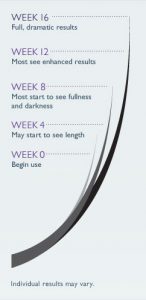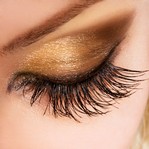Your eyelashes – a feature you usually don’t think about, unless and until something causes you to notice them. For instance, when they’re thinning, falling out, showing gaps, and just not doing their job!
There are lots of reasons for changes in the hairs on your eyelids; many are medical, and just as many are habit-related. (*as in, when you try to remove a ‘mascara blob’ by pulling it away – and the action results in a handful of eyelashes with a mascara clump holding them together. Don’t do that.)
A few years ago, a product called Latisse came on the market. It promised to “grow eyelashes.” It even claimed that with regular use, the individual lashes would grow in thicker and darker. It met with some skepticism at first, as products often do. But in this case, it delivered.
Latisse, made by Allergan, proved its claims, and won approval from the FDA for eyelash growth.
(un-retouched, makeup-free photos provided by Allergan-)
People have been using it successfully for a long time now, but potential patients still have lots of questions about it. We’re repeating some of the most common questions about Latisse, and the answers:
Q: I’ve heard that Latisse was developed from a drug used to treat glaucoma. Is it dangerous to use it in an otherwise healthy person? (Will it cause glaucoma- or affect me if I do have it?)
A: Latisse was discovered as a side effect of a prescription called Lumigan, used to treat Glaucoma. Patients using Lumigan would drop it directly into the eye, as an eye drop. In the clinical trials, it was noted that patients’ eyelashes were growing in thicker and darker. Those side effects lead to the development of Latisse. The new drug (Latisse) went through its own clinical FDA trials, as a ‘dermal application’ – applied to the upper eyelid at the base of the eyelash, instead of being dropped directly into the eye.
It is safe for otherwise healthy patients, and will not cause Glaucoma. But, women who are pregnant or breast feeding, and patients using inter-ocular medications for certain eye disorders, should be monitored closely and consult their physician for advice on the use of Latisse.
Q: How does it work?
A: The hair follicles on your head, your eyelashes, and eyebrows, are on the same growth cycle. There is a growth phase, a transition phase, resting phase, and exogen phase- where the hair follicle eventually falls out, and the new one takes its place. The cycle takes about 4 to 9 months to complete.
The exact mechanism of action influenced by Latisse, is believed to lengthen the growth phase (the anagen phase) of the eyelash hair follicle, so the eyelash grows in longer, thicker, and darker, and for a longer period of time.
Q: When will I see new eyelash growth?
A: You can see early results at 8 weeks into treatment, however, for the full effect, it’s recommended you use the product for the complete 16 week period described in its literature. After the 16 weeks, some patients choose to adopt a “maintenance dose” of 3 to 4 applications a week. The manufacturers say, in order to keep the optimal outcome, daily application is recommended.

from: Allergan Latisse site- What To Expect chart: recommended you use the product for the complete 16 week period described in its literature. After the 16 weeks, some patients choose to adopt a “maintenance dose” of 3 to 4 times a week. The manufacturers say, in order to keep the optimal outcome, daily application is recommended.
Q: After the 16-week treatment period, how long will my ‘new’ thicker and longer lashes remain that way? Will they start to fall out after a few weeks?
A: You will need to use Latisse daily to fully maintain your results. When you stop using it, your eyelashes will revert to their normal, shorter growth cycle in about 3 to 4 months. The individual lashes will fall out once the hair follicle has reached the ‘exogen phase’ described earlier.
Q: How often should I start a new round of treatment with Latisse?
A: Latisse is an ongoing treatment, used daily for optimal outcomes, according to manufacturer directions.
Q: Will Latisse work on growing eyebrows as well?
A: Latisse, theoretically, works in similar fashion on other hair follicles. Many patients do report growth when they apply it to their eyebrows. The drug has not yet undergone FDA trials for the eyebrow, so this use is not included in the indications or recommendations from the manufacturer.
Q: (**and now, the single most-asked question about Latisse)
If Latisse does such a good job of growing eyelashes, what about the hair on my head? Can I use it for that too?
A: Latisse is currently FDA-approved and indicated only for the eyelash. (However, that doesn’t mean the subject isn’t under study. If we hear any developments, we will let you know!)
[Many thanks to our helpful and knowledgeable Allergan representatives for their assistance in answering your questions. Latisse is available through doctors’ offices, which, like ours, frequently offer special pricing, due to the popularity, and ongoing use of this product.
Dr. Vincent Lepore is a Board Certified Plastic Surgeon, providing a full range of Cosmetic and Reconstructive Plastic Surgery procedures to patients throughout the San Jose and San Francisco Bay Areas. Please call to schedule your free Cosmetic Consultation, (408) 356-4241.]





